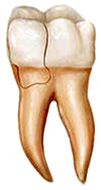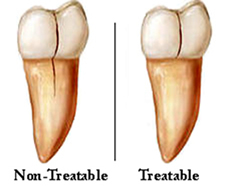Cracked Teeth
 |
Fractured Cusp. Fractured cusps usually occur when you bite down on something hard. It is possible for a portion of the cusp to fracture off or the entire cusps. Please have your dentist evaluate if the fracture area involved the pulp, which would indicate a root canal would be needed. Please inform the dentist if any bleeding occurred. Ideally the pulp would not be involved and the dentist would be able to restore the fractured cusp.
|
 |
Vertically Cracked Tooth. This type of crack extends from the top of the chewing surface toward the roots. Sometimes, the fracture extends below the gum tissue and the extent of the fracture cannot be determined without a conventional root canal. Once the root canal has been started, the extent of the fracture can be determined using our endodontic microscopes. If your dentist or Dr. Baker believes a small crack is present, a root canal will be recommended to protect the life of the tooth and prevent worsening the prognosis.
|
 |
Split Tooth. If a tooth has a small-untreated fracture, it is possible the tooth might completely split over time. Depending where the split is located will determine if the tooth or any part of the tooth can be saved. Sometimes, a portion of the tooth can be saved with a guarded prognosis. Treatment of a split tooth would involve consulting with your dentist.
|
 |
Vertical Root Fracture. A vertical root fracture begins at the tip of the root and extends to the crown or chewing surface. Some patients experience extensive pain or discomfort when biting down. Treatment would involve endodontic surgery if Dr. Baker feels the tooth can be saved. Otherwise the tooth will have to be extracted.
|


